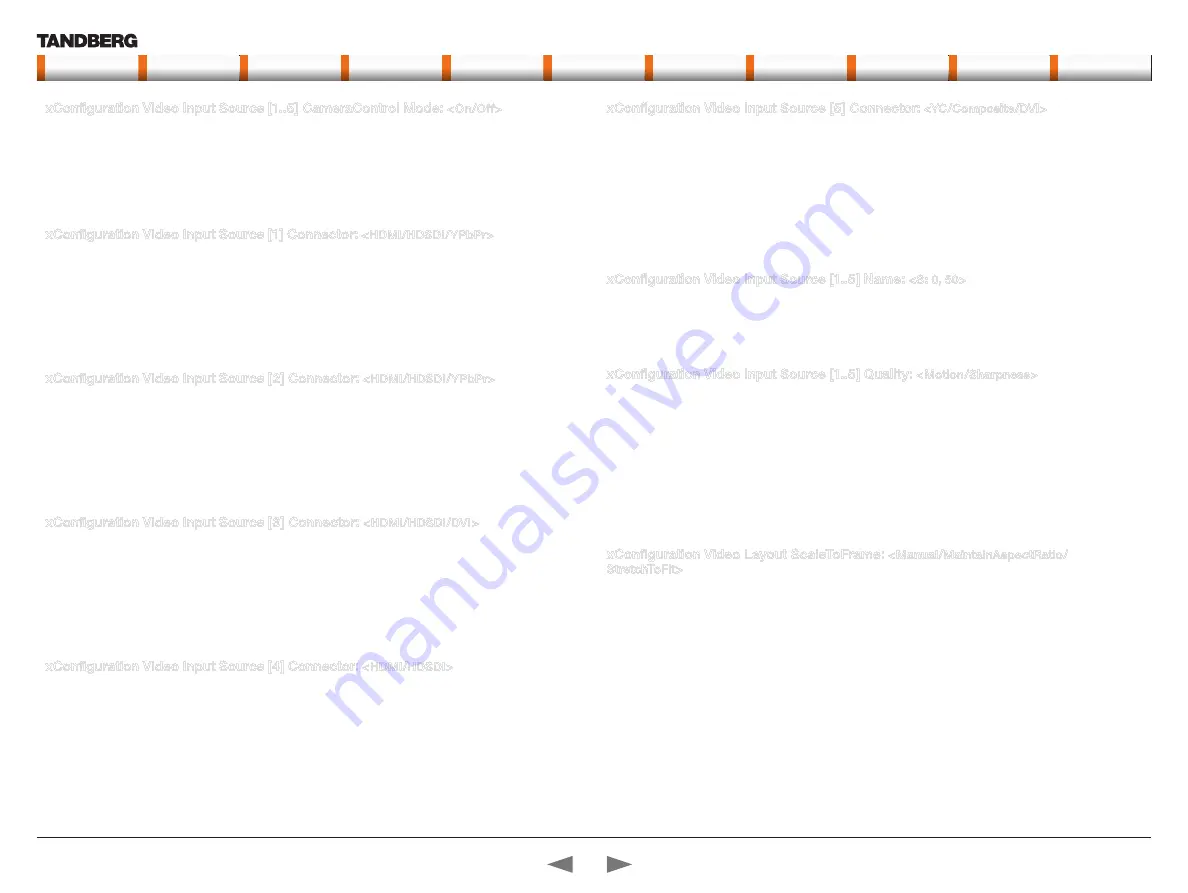
D14128.03—JULY 2009
65
Codec C90
System Integrator Guide
Contents
Introduction
Getting Started
Interfaces
About the API
xConfiguration
xCommand
xStatus
Cameras
Appendices
Contact us
xConfiguration Video Input Source [1..5] CameraControl Mode:
<On/Off>
Determines whether or not the camera control should be enabled for the specific video input source.
Addresses the specific video input source.
On: Set to On to enable camera control for the camera connected to the selected video input connector.
Off: Set to Off to disable camera control for the camera connected to the selected video input connector.
Example:
xConfiguration Video Input Source 1 CameraControl Mode: On
xConfiguration Video Input Source [1] Connector:
<HDMI/HDSDI/YPbPr>
Select which video input connector to be active on connector group 1. The available options for Source 1
are listed below.
HDMI: Select HDMI when you want to use the HDMI 1 connector as input.
HDSDI: Select HD-SDI when you want to use the HD-SDI 1 connector as input.
YPbPr: Select YPbPr when you want to use the Y-Pb-Pr (Component) 1 connectors as input.
Example:
xConfiguration Video Input Source 1 Connector: HDMI
xConfiguration Video Input Source [2] Connector:
<HDMI/HDSDI/YPbPr>
Select which video input connector to be active on connector group 2. The available options for Source 2
are listed below.
HDMI: Select HDMI when you want to use the HDMI 2 connector as input.
HDSDI: Select HD-SDI when you want to use the HD-SDI 2 connector as input.
YPbPr: Select YPbPr when you want to use the Y-Pb-Pr (Component) 2 connectors as input.
Example:
xConfiguration Video Input Source 2 Connector: HDMI
xConfiguration Video Input Source [3] Connector:
<HDMI/HDSDI/DVI>
Select which video input connector to be active on connector group 3. The available options for Source 3
are listed below.
DVI: Select DVI-I when you want to use the DVI-I 3 connector as input.
HDMI: Select HDMI when you want to use the HDMI 3 connector as input.
HDSDI: Select HD-SDI when you want to use the HD-SDI 3 connector as input.
Example:
xConfiguration Video Input Source 3 Connector: DVI
xConfiguration Video Input Source [4] Connector:
<HDMI/HDSDI>
Select which video input connector to be active on connector group 4. The available options for Source 4
are listed below.
HDMI: Select HDMI when you want to use the HDMI 4 connector as input.
HDSDI: Select HD-SDI when you want to use the HD-SDI 4 connector as input.
Example:
xConfiguration Video Input Source 4 Connector: HDMI
xConfiguration Video Input Source [5] Connector:
<YC/Composite/DVI>
Select which video input connector to be active on connector group 5. The available options for Source 5
are listed below.
DVI: Select DVI-I when you want to use the DVI-I 5 connector as input.
YC: Select YC when you want to use the S-Video (YC) input. Connect the S-Video input to the connector
marked as Y/Comp and C. NOTE! This configuration is not supported in version 1.
Composite: Select Comp when you want to use the Composite input. Connect the Composite input to the
connector marked as Y/Comp NOTE! This configuration is not supported in version 1.
Example:
xConfiguration Video Input Source 5 Connector: DVI
xConfiguration Video Input Source [1..5] Name:
<S: 0, 50>
Customizable name of the connector group. Enter the name of the video input source 1-5.
Format: String with a maximum of 50 characters.
Example:
xConfiguration Video Input Source 1 Name: “”
xConfiguration Video Input Source [1..5] Quality:
<Motion/Sharpness>
When encoding and transmitting video there will be a tradeoff between high resolution and high framerate.
For some video sources it is more important to transmit high framerate than high resolution and vice versa.
The Quality setting specifies whether to give priority to high frame rate or to high resolution for a given
source. Addresses the selected video input connector.
Motion: Gives the highest possible framerate. Used when there is a need for higher frame rates, typically
when a large number of participants are present or when there is a lot of motion in the picture.
Sharpness: Gives the highest possible resolution. Used when you want the highest quality of detailed
images and graphics.
Example:
xConfiguration Video Input Source 1 Quality: Motion
xConfiguration Video Layout ScaleToFrame:
<Manual/MaintainAspectRatio/
StretchToFit>
Defines what to do if the aspect ratio of a video input source doesn’t match the aspect ratio of the
corresponding image frame in a composition. For example if you have a 4:3 input source (like XGA) to be
displayed on a 16:9 output (like HD720).
Manual: If the difference in aspect ratio between the video input source and the target image frame is less
than the ScaleToFrameThrshold configuration (in percent), the image is stretched to fit. Unless the system
will maintain the original aspect ratio.
MaintainAspectRatio: Will maintain the aspect ratio of the input source, and fill in black in the rest of the
frame (letter boxing or pillar boxing).
StretchToFit: Will stretch (horizontally or vertically) the input source to fit into the image frame.
Example:
xConfiguration Video Layout ScaleToFrame: MaintainAspectRatio
Contents
Introduction
Getting started
Interfaces
About the API
xConfiguration
xCommand
xStatus
Cameras
Appendices
Contact us
xConfiguration
















































